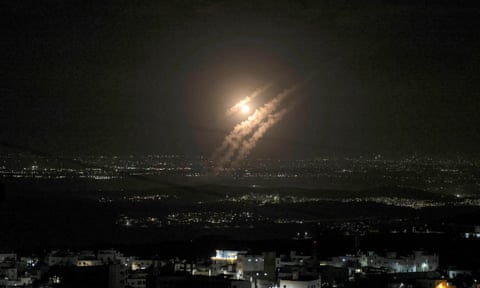'Axis of Resitance' Agitating for War
"[Israel's response to the Iranian attack would be] very strong [and] painful, [yet calculated since] we don't want to see a full war with Iran.""We have shown our capabilities when we fought Hamas in Gaza, and we are fighting Hezbollah in Lebanon.""They better look at what happened in Beirut and in Gaza before they start a war with us."Israel's Ambassador to the UN, Danny Danon"[They had been hiding in a] fortified and equipped underground compound in northern Gaza.""The compound served as a Hamas command and control centre and enabled senior operatives to remain inside of it for extended periods of time."Israel Defense Forces
 |
| Iranian missiles above the Israeli city of Ashdod during Tuesday’s attack. Photograph: Hazem Bader/AFP/Getty Images |
The
IDF and Israeli Foreign Ministry announced that Hamas had lost more of
its leaders -- "eliminated" -- through a joint effort of the military
and the Israeli Security Agency. Rawhi Mushtaha, head of Hamas in Gaza,
along with commander of Hamas's general security mechanism, Sami Oudeh
and Sami al-Siraj head of the security portfolio of the group's
political bureau were struck by Israeli fighter jets. Hamas commanders
and unit heads are getting a little thin on the ground of late.
And
nor are matters looking any rosier for Hamas's sister terrorist group,
Hezbollah. The Israeli Air Force made note that Khider al-Shaebia,
responsible for firing the rocket at the Majdal Shams area of Golan
Heights too was eliminated. He "was responsible for firing rockets at Majdal Shams in July in which twelve children were murdered", the IDF posted.
Some
200 Hezbollah targets across Lebanon were struck by Israeli forces.
Among the targets hit included the intelligence headquarters of
Hezbollah in central Beirut, days following an Iranian missile attack
against Israel coupled with a deadly shooting attack in Tel Aviv-Jaffa
that Hamas was proud to claim responsibility for. Weapons storage
facilities and observation posts were the primary targets, while the
strikes also killed 15 Hezbollah operatives.
One
of the targeted buildings was located in a neighbourhood less than a
15-minute walk from the Lebanese Parliament. This past Thursday saw
Hezbollah launch about 75 rockets and a few drones toward northern
Israel. "This is how Israelis are starting off the Jewish New Year; under Hezbollah rocket fire from Lebanon", posted the Israeli Foreign Ministry.
Iran's
ballistic missile shower took place on Tuesday night, followed by
Hezbollah launching rockets the next day, an event that precipitated the
Israeli airstrike in response. Iran "will pay for it", stated Prime Minister Benjamin Netanyahu, who characterized the Tuesday event as a "big mistake".
Houthi rebels in Yemen, backed by Iran, boasted of launching two drones
at Tel Aviv -- one of which was shot down, the other falling into the
Mediterranean Sea.
Hamas
to the south, Hezbollah to the north and the Houthis form part of the
Iranian strategic 'Axis of Resistance', of which armed Shiite groups in
Syria and Iraq form a part. They claim their attacks as Iranian puppets,
launched on Israel represent their solidarity with the Palestinians.
Once again, the tinderbox region appears to teeter on the brink of a
wider conflict, as a result of the Islamic Republic of Iran's missile
shower over Israel.
Iran's
rationale for challenging Israel yet again in a show of missile-power
-- in which some damage ensued in Israel, although most of the missiles
were shot down, and many of them that were not destroyed broke up over
open fields fizzled just as the similar April attack did. There were no
casualties, but for a Palestinian man in Gaza being fatally struck by a
descending missile breaking up over a highway.
Iran's
decision to attack Israel was motivated as a response to the
assassination of Hamas leader Hassan Nasrallah and the death of an
Iranian Revolutionary Guard general with Nasrallah at the time. Ismail
Haniyeh, the political leader of Hamas was killed in an explosion in
Tehran. Commander Saeed Attallah Ali and his family were killed on
Saturday in
the Israeli bombardment of his house in the Beddawi camp, near the
northern city of Tripoli. Ali has been identified as a leader of Hamas’s
armed wing, the Qassam Brigades.
This,
following on the thousands of injuries and some deaths ensuing from
booby-trapped IEDs in the form of walkie-talkies and tablets, basic
communication devices that proved to be valuable instruments of war,
taking Hezbollah by surprise in its harvest of Hezbollah operatives.
 |
| This building was hit by an Israeli strike that, according to Hamas and a Lebanese security source, killed Saeed Atallah Ali, a leader in Hamas's armed wing, the Qassam Brigades, alongside his wife and two daughters [Omar Ibrahim/Reuters] |
"We shouldn’t read too much into the rhetoric … the Palestinian groups [Hamas/Hezbollah/Houthis] do not have the capability to escalate outside the [occupied] West Bank, while the Israelis have been so successful in [the] last couple of weeks that I don’t think Lebanese Hezbollah can come to Iran’s defence."Edmund Fitton-Brown, senior adviser, Counter-Extremism Project
Labels: Axis of Resistance, Challenging Israel to War, Islamic Republic of Iran

<< Home